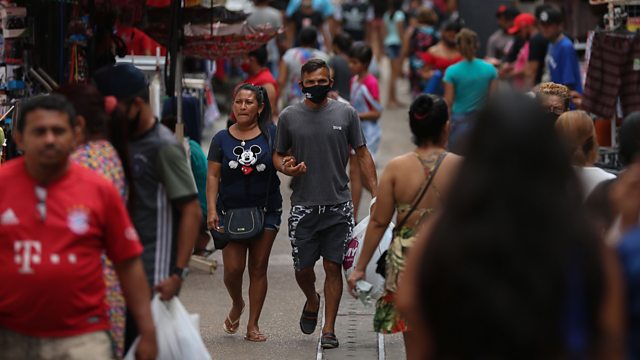The unchecked spread of Covid-19 in Manaus
Around three-quarters of the Brazilian city’s population are thought to have been infected
Pictures of coffins and mass graves seen by satellites showed that Manaus has been badly affected by Covid- 19. Now analysis of blood samples shows the extent to which the virus took hold in the Amazon city earlier this year. Investigators Ester Sabino and Lewis Buss from Brazil’s University of Sao Paulo discuss how and why the virus spread.
Humanity has been modifying the environment for millennia, but have we now reached a point where it’s all too much? An analysis by Emily Elhacham from Tel Aviv University shows the amount of stuff produced by humanity, from plastics to buildings now has a greater mass than all natural biomass on the planet.
And China has been to the moon. Space watcher Andrew Jones tells us how the robotic mission mimics the manned missions of the 1960s and 70s.
The space between stars is usually measured in light years, but this makes it less easy to acknowledge the true scale of the distance. Even the closest star system to Earth, Proxima Centauri, is 4.2 light years or 40.13 trillion kilometres from Earth. If we are ever going to bridge the gap between the stars, we will have to have some very fast spaceships, with extremely reliable, long-lasting technology on board.
So does science allow for these spacecraft to exist? That’s what listener Allan wants to know, and to find out, Presenter Anand Jagatia speaks with Tracy Drain, a systems engineer at NASA JPL responsible for overseeing the development and missions of multiple unmanned interplanetary probes including some around Jupiter and Mars. She tells us the challenges involved with simply keeping our spacecraft working for the long-haul.
Even if we can overcome issues of wear and tear over time, powering a ship to other star systems will not be easy. Today’s chemical rockets are too inefficient for the job, so we speak with Rachel Moloney, a researcher in electric propulsion to ask if this relatively new technology could power ships through interstellar space.
Faster than light travel is the solution most often found in Science Fiction, but it goes against Einstein’s laws of relativity. Is there a way around it? Theoretical physicist Professor Miguel Alcubierre thinks there may be, and he describes the way a spaceship may be able to create a bubble of spacetime around itself to move faster than light without breaking these fixed laws. But there’s a catch...
(Image: Getty Images)
Last on
More episodes
Broadcasts
- Sun 13 Dec 2020 01:06GMT���˿��� World Service
- Sun 13 Dec 2020 16:06GMT���˿��� World Service News Internet
Podcast
-
![]()
Unexpected Elements
The news you know, the science you don't


